The tomato is a staple of the average garden. This versatile vegetable (which is technically a fruit) can be used for so many different things and come in a wide range of varieties. While they do well growing in a pot by themselves, there are actually quite a few tomato companion plants that can boost the health and yield of your tomatoes!
Let’s take a look at some of the best tomato companion plants to grow alongside any tomato variety you might be growing. But to start, let’s take a look at some plants that you might want to avoid planting with your tomatoes. While there aren’t many plants out there that could outright damage your tomato plants, there are some plants that may not be very beneficial. If you really want to grow the following plants in the same garden, just be sure to give them some space away from your tomatoes.
Plants to Avoid Planting with Your Tomatoes
1. Cabbage
For a number of reasons, tomatoes and cabbage are not the best garden mates. To start, the nutritional needs of the two plants are very different. While tomatoes demand a balanced nutritional profile for their soil, cabbage prefers soil that is high in nitrogen. When they are planted together, the soil’s nutrient balance may become unbalanced. This would be detrimental to the growth and development of both plants.
There are also comparable illnesses and pests that affect both tomatoes and cabbage. When they are planted near each other, there is a greater chance of illnesses and infestations quickly spreading between the two crops. For example, cabbage worms may quickly transition from tomato plants to cabbage plants, and will harm them both.
These plants also develop in quite different ways. As a rule, cabbage plants are larger and have thicker foliage, which shades the nearby tomato plants. This shade may prevent the tomatoes from getting enough sunlight, affecting fruit output and general plant vitality.
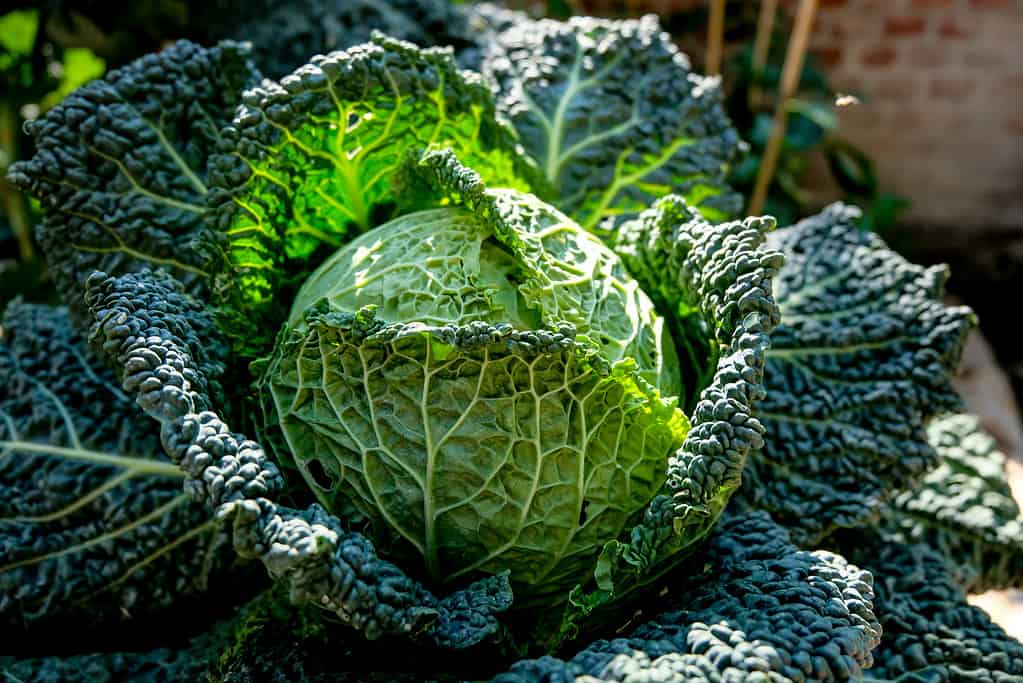
Tomatoes and cabbage (pictured) can be grown in the same garden but should be kept at least a few feet away from each other.
©Vito Cangiulli/Shutterstock.com
2. Fennel
Fennel is well known for its allelopathic qualities, which refers to the compounds it emits that prevent the growth of nearby plants. When grown near tomato plants, these substances can have a negative impact on their development and production.
Just as well, fennel and tomatoes demand different amounts of water and nutrients. While tomatoes need regular hydration, fennel enjoys well-draining soil that is somewhat dry. When they are planted together, there may be competition for water and nutrients. This might stress both plants and diminish their yields.
Aphids and caterpillars can infest tomato plants. They are also two pests that are drawn to fennel. The likelihood of disease outbreaks and insect infestations is increased when they are grown together.
3. Eggplant
Both plants are members of the Solanaceae family and are susceptible to the same diseases and pests. When they are planted near each other, there is a higher chance that shared pathogens such fungi or aphid infestations would readily move between the two crops.
Tomatoes and eggplant also require a lot of nutrients. If they are planted together, there may be fierce competition for nutrients in the soil, which would restrict both plants’ development and diminish their harvests.
Tomatoes and eggplant also both have expansive growth patterns and substantial foliage, which can result in thick canopies. These canopies inhibit airflow and sunlight penetration, so fungus infections are more likely to spread and the health of the plants as a whole is compromised.
4. Dill
Dill is known to attract helpful insects like wasps and ladybugs, which feed on aphids and caterpillars. Aphids and caterpillars are two typical pests of tomatoes. Seems like a match made in heaven, right? Unfortunately, the presence of these advantageous insects might also cause pollinators to eat tomato pollen, thereby lowering fruit set and production.
If allowed to go to seed, dill also has a propensity to self-seed and spread very quickly. This may cause the dill plants to dominate the nearby tomato plants. This could stunt their development and limit their access to sunlight.
Tomatoes and dill require different amounts of water as well. While tomatoes need continuous hydration, dill enjoys rather dry soil. Co-planting them might result in irrigation disputes and unequal watering techniques, which would impact both plants’ development and health.
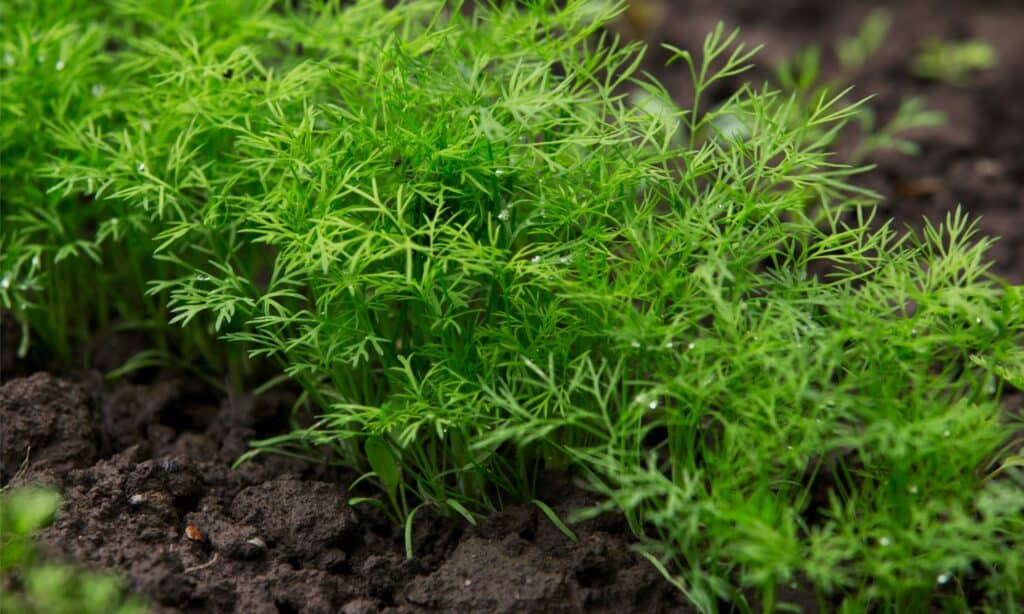
Dill (pictured) is a delicious herb, but it should be kept away from tomato plants.
©iStock.com/DevidDO
5. Broccoli
Different spacing requirements apply to both broccoli and tomatoes. While tomatoes have a more compact growth pattern, broccoli normally develops as a big, leafy plant that needs enough space for its entire development. When they are planted together, there may be overcrowding and resource rivalry. This can result in stunted development and lower yields for both crops.
Tomatoes and broccoli require different types of fertilization. While tomatoes prefer a more balanced nutritional profile, broccoli is a strong feeder and needs a lot of nitrogen. Co-planting them might lead to nutritional imbalances in the soil, which would be bad for both plants’ growth and development.
Just as well, there are similarities in the pests and illnesses that affect broccoli and tomatoes. When they are grown together, there is a higher chance that they may have shared infestations like aphids or caterpillars. These infestations can swiftly spread across the two crops and cause extensive harm.
Now that we know which plants aren’t so great for tomatoes, let’s move on to some tomato companion plants that can absolutely help them thrive!
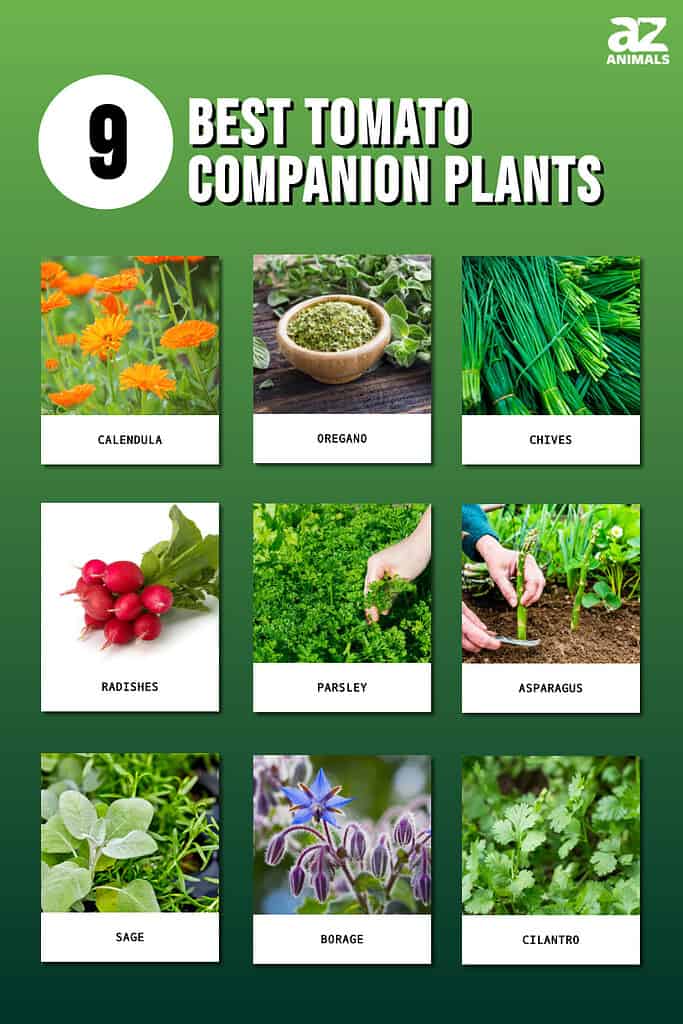
The Best Tomato Companion Plants
1. Calendula
There are a number of reasons why calendula is such a great plant to grow next to tomatoes. To start, pollinators like bees and butterflies are drawn to the calendula’s vivid, daisy-like blossoms. These pollinators dramatically improve fruit set and flower pollination in tomato plants, thus increasing yields.
The second benefit of calendula is that it naturally repels pests. Because of its fragrant scent, typical tomato pests like aphids and whiteflies are pushed away, lowering the likelihood of infestations and plant damage.
Calendula is also renowned for its capacity to enhance soil health. Its deep taproots aid in loosening up compacted soil, which benefits the nearby tomato plants’ drainage and aeration. Calendula also functions as a dynamic accumulator, bringing nutrients from deeper soil layers to the surface and distributing them to neighboring plants. Overall, calendula contributes to the health and beauty of any garden while promoting the development of tomato plants.

Calendula plants are often sticky to the touch!
©Yulia_B/Shutterstock.com
2. Oregano
Aphids, spider mites, and whiteflies are just a few of the frequent pests that oregano’s strong aroma deters. Tomatoes grown near oregano plants are protected from any infestations by the fragrant oils’ inherent deterrent effects.
Oregano has beneficial effects on the growth and flavor of tomatoes. When tomatoes are grown nearby, they can absorb beneficial compounds in oregano oil that can improve their flavor. The oregano plant’s essential oils can thus help improve the general well-being and vitality of tomato plants.
Oregano can also create a favorable microclimate for tomatoes. Its thick foliage can provide natural shade (without creating too large of a canopy) and aid in maintaining soil moisture, both of which are advantageous during the hot summer months.
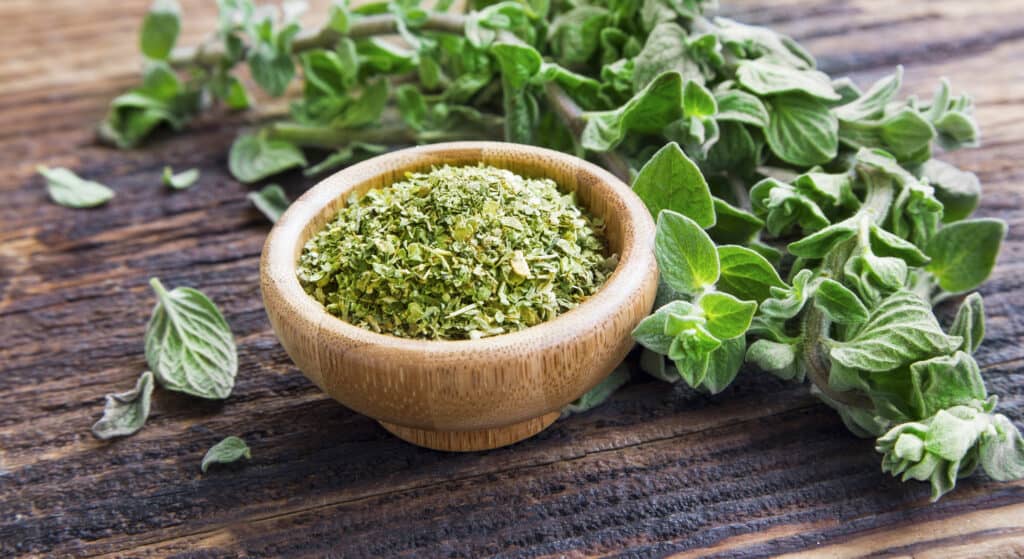
Oregano is an excellent herb to grow near tomatoes, especially if you want to enhance their flavor.
©catalina.m/Shutterstock.com
3. Chives
The pungent scent of chives deters typical tomato pests like aphids and mites. There’s no need for artificial pesticides because of chives’ inherent ability to reject pests, which is beneficial for both the chives and nearby tomatoes.
Just as well, chives draw helpful insects like hoverflies and bees, which are crucial for pollinating tomatoes. For tomatoes, better pollination results in more fruit set and higher yields.
The short roots of chives also aid in improving moisture retention and reducing soil erosion. They produce a favorable microclimate by growing next to tomatoes, shading the soil and lowering water evaporation. This is particularly advantageous in hot climes or during dry spells.
Chives are also known to improve the flavor of tomatoes. Their complementary tastes provide for a delicious culinary blend when they are planted together.
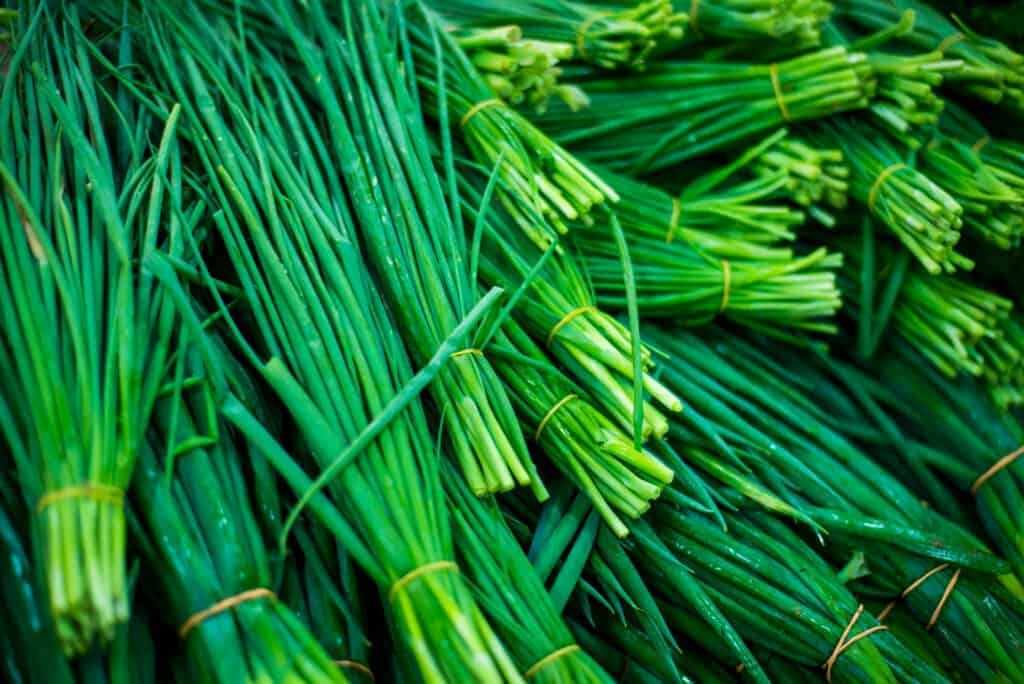
Chives repel tomato pests while attracting insects needed for tomato pollination.
©Heitor Pergher/Shutterstock.com
4. Radishes
Due to their rapid growth and shallow root systems, radishes can help loosen up compacted soil and enhance soil structure. By providing improved root penetration and water infiltration, this benefits nearby tomato plants as well as many other types of garden plants.
Radishes also function as organic insect repellents. Pests that commonly harm tomato plants, such as aphids, flea beetles, and cucumber bugs, are repelled by their strong scent. You can assist protect your tomatoes from these pests and lessen the need for chemical pest control measures by planting radishes nearby.
Radishes can also be used as sacrificial plants. Radishes are preferred by some pests over tomatoes. Root maggots are one example of these pests. You can prevent harm to your priceless tomato crop by drawing these bugs away from the tomatoes and toward the radishes instead.
Radishes can also be picked before tomatoes reach their full size due to their relatively short growing season. This makes it possible to use your garden’s space effectively.
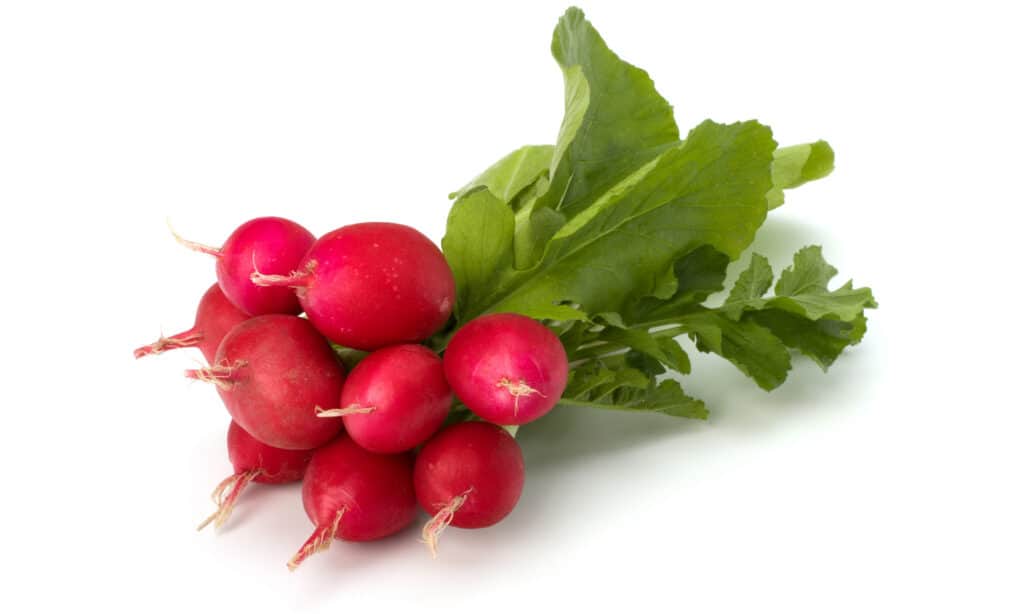
Radishes can help loosen up compacted soil, enhance soil structure, and repel insects.
©iStock.com/Natikka
5. Parsley
Hoverflies and parasitic wasps, which feed on typical tomato pests like aphids and caterpillars, are drawn to parsley. Parsley can help to reduce pest numbers and defend tomato plants by luring these pesky insects.
Parsley has extensive roots that enhance the structure and drainage of the soil it is planted in. In order to help the nearby tomatoes, its root system also aids in bringing nutrients from deeper soil layers to the surface.
Parsley also functions as a living mulch. It preserves soil moisture and inhibits weed development. It also provides natural shade. This may be especially helpful in hot and dry weather since it guarantees the tomatoes have enough moisture for healthy growth. Just as well, when planted close to each other, parsley can improve the flavor of tomatoes.
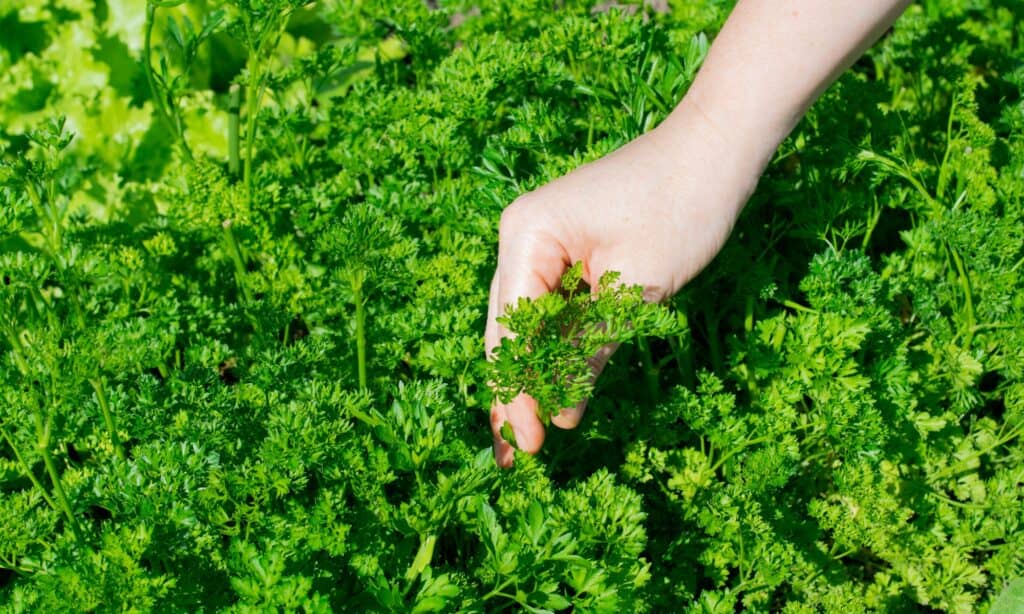
Parsley (pictured) comes in several varieties, all of which make great tomato companion plants.
©iStock.com/Oksana Chaun
6. Asparagus
The wide and deep root systems of asparagus can aid in enhancing the structure and drainage of soil. This can improve the root growth and nutrient absorption of nearby tomato plants.
Delicate tomato plants can be shielded from too much sun exposure by asparagus ferns, which offer a natural shade canopy, particularly during the hot summer months. Asparagus’s shadow helps lessen heat exhaustion and shield tomato fruit from sunburn. It’s worth noting that these ferns do not create overcrowded canopies naturally. However, if multiple asparagus are crowded together, they might cause more harm than good.
Asparagus plants are often tall and erect, which benefits tomato plants by acting as a windbreak. Strong wind damage may be avoided in this way, and healthy development can be encouraged.
Also, when compared to tomato plants, asparagus plants have a distinct development cycle. Tomatoes are an annual. Asparagus are a perennial. Together, they make effective use of the available garden space and produce continuously throughout their respective growing seasons.
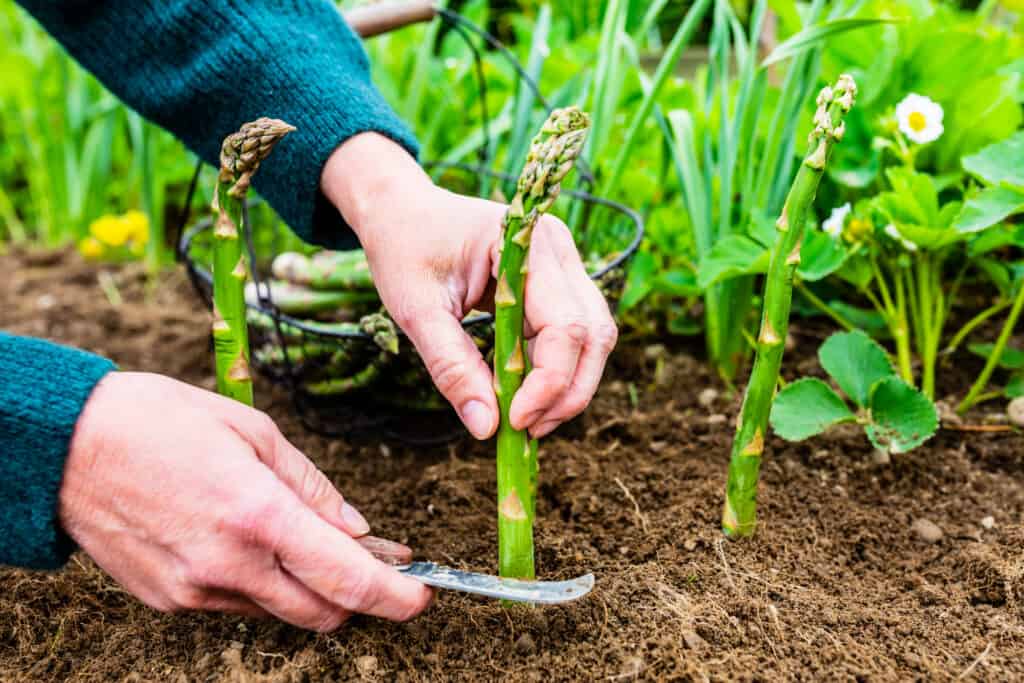
The wide and deep root systems of asparagus can aid in enhancing the structure and drainage of soil.
©iMarzi/Shutterstock.com
7. Sage
Pests like cabbage worms, carrot flies, and several types of beetles are naturally repelled by the pungent odor that sage generates. Sage may be grown next to tomatoes to help ward off pests and lessen the likelihood of infestations.
The second benefit of sage is that it draws helpful insects like bees and butterflies, which are essential for pollinating tomato blooms. For tomatoes, enhanced pollination results in better fruit development and higher yields.
Sage also has a deep root system that enhances soil quality and water retention. Encouraging greater root development and lowering the likelihood of water stress can be advantageous to nearby tomato plants. When grown near together, the aromatic compounds in sage can also improve the flavor of tomato fruits.
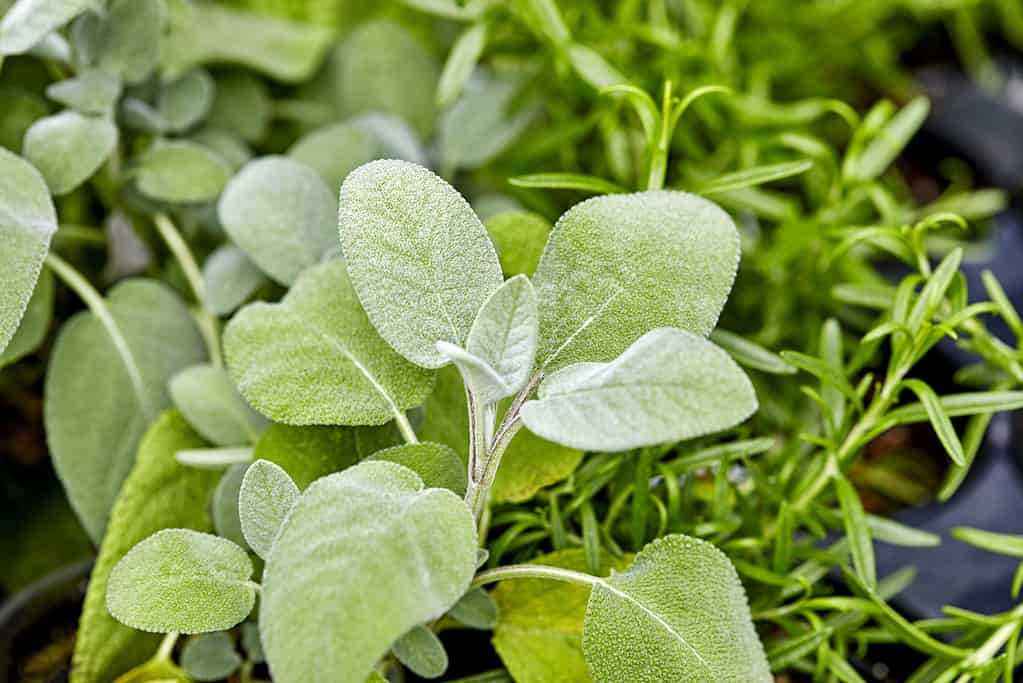
Fresh organic sage produces a scent that repels garden pests but attracts pollinators.
©iStock.com/wingedwolf
8. Borage
Borage is well-known for its lovely blue blossoms, which draw pollinators like bees and butterflies to them. The fruit set and output of tomatoes are aided by these pollinators. And plus, they add a pop of color to vegetable gardens that may be a bit plain.
The deep taproots of borage contribute to better soil structure and nutrient absorption as well. By loosening up compacted soil, its root structure aids nearby tomato plants in receiving more water and better development of their roots.
Borage also serves as a natural insect deterrent. The danger of infection and injury to the tomato plants is decreased because of the substances released by the borage’s leaves, which scare off pests like tomato hornworms and cabbage worms.
Borage is also a fantastic source of calcium and potassium. These are two elements necessary for the growth and development of tomatoes and their fruits. Borage can be grown close by to restore these nutrients in the soil, which will help the tomatoes greatly.
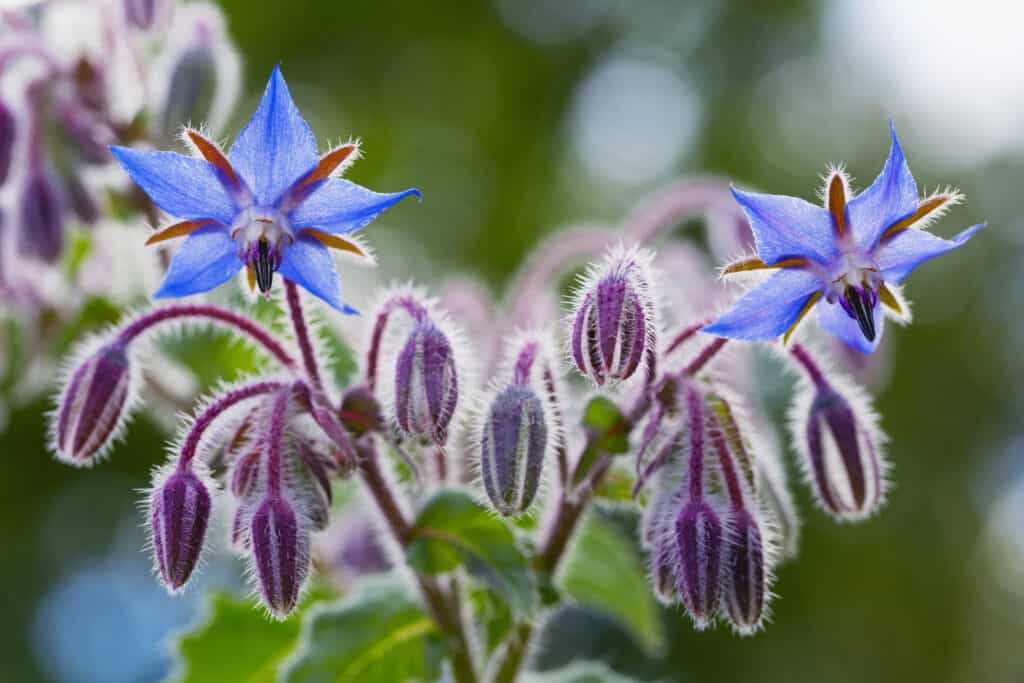
Borage (pictured) make very aesthetically pleasing tomato companion plants.
©matteo sani/Shutterstock.com
9. Cilantro
Hoverflies and parasitic wasps that feed on typical tomato pests are attracted to cilantro. Cilantro can help with pest management and defend tomato plants by luring these harmful insects.
The distinctive root system of cilantro also enhances the structure and drainage of its soil. Its dense roots loosen up compacted soil, which improves water infiltration and nearby tomato root development.
Cilantro is also capable of shading tomato plant roots if allowed to grow fairly large. This aids in preserving soil moisture and controlling soil temperature. This can be especially useful in the sweltering summertime for tomatoes.
Also, cilantro enhances the flavor of tomatoes in a variety of culinary preparations. Growing them together makes it easy to have access to fresh herbs for cooking or serving as a garnish with tomatoes.
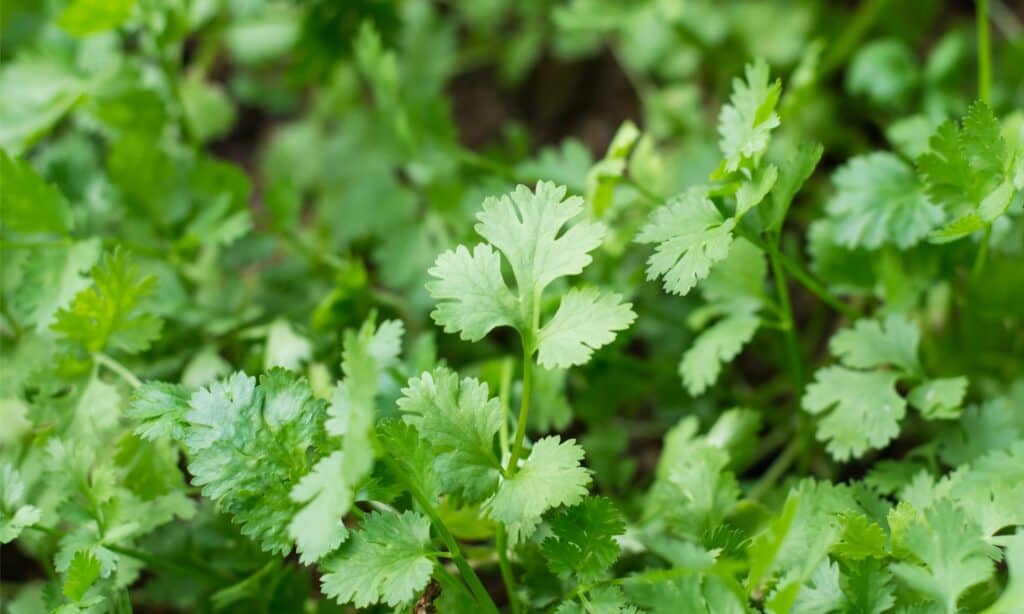
Cilantro, also known as coriander, attracts helpful insects and loosens compacted soil.
©iStock.com/Tevarak
Summary of 9 Best Tomato Companion Plants:
Almost all of these tomato companions deter pest, attract pollinators, and enhance the structure of drainage of the soil. This table highlights a special attribute of each plant.
| Name of Plant | Special Attribute |
|---|---|
| Calendula | Dynamic accumulator, bringing nutrients from deeper soil layers to the surface and distributing them to neighboring plants. |
| Oregano | Beneficial effects on the growth and flavor of tomatoes. |
| Chives | Enhances the flavor of tomatoes in culinary preparations. |
| Radishes | Can also be used as sacrificial plants to those bugs that prefer them to tomatoes. |
| Parsley | Functions as a living mulch and improves the taste of tomatoes if grown together. |
| Asparagus | Complementary growing cycles make efficient use of garden. |
| Sage | Enhances the flavor of tomatoes when grown side by side. |
| Borage | Adds color to the garden; source of calcium and potassium. |
| Cilantro | Enhances the flavor of tomatoes in culinary preparations. |
The photo featured at the top of this post is © Shannon Birchler/Shutterstock.com
Thank you for reading! Have some feedback for us? Contact the AZ Animals editorial team.







